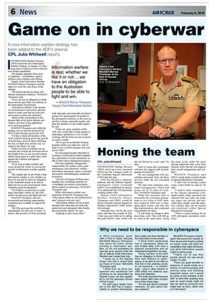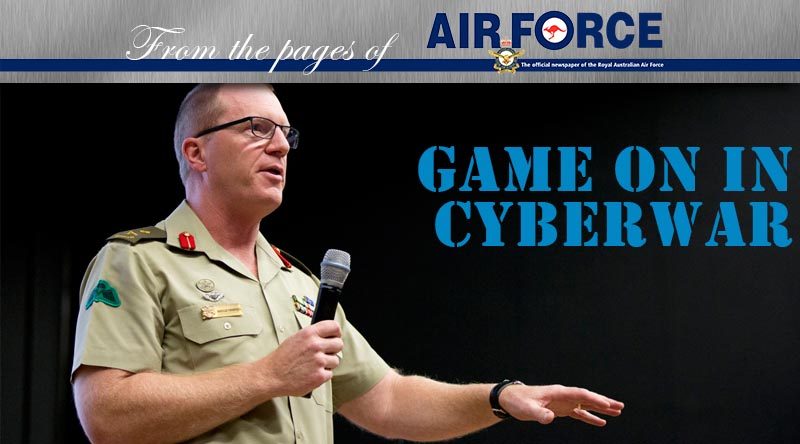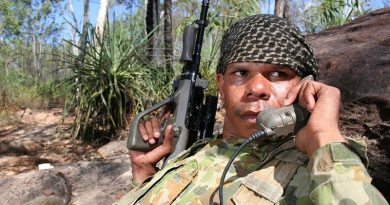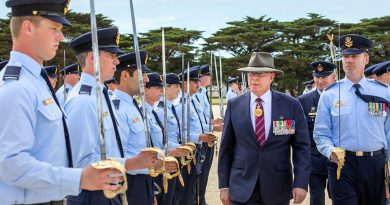ADF’s new offensive mission in cyber warfare

(published in all three Defence newspapers 8 February 2018)

A new information warfare strategy has been added to the ADF’s arsenal, CPL Julia Whitwell reports
INFORMATION Warfare Division (IWD) issued the new Information Warfare Strategy on January 29, flagging areas of rapid growth in information-related capabilities.
The strategy identifies four areas of capability – self-defence, passive defence, active defence and offence.
Deputy Chief Information Warfare MAJGEN Marcus Thompson said the latter two were the main focus of the strategy.
“We should already be doing selfdefence and passive defence,” MAJGEN Thompson said.
“Everyone has an obligation to think about and act upon their own defence in the information environment.
“And passive defence is the domain of communicators and system administrators to make sure that our networks and mission systems are protected.
“Much of the conversation in this domain falls in the active defence and offence, and they’re the capabilities we’re growing quickly.” MAJGEN Thompson said while the strategy was an internal document for IWD it had relevance across the ADF.
“I’d like to think all members of the ADF would be looking across the growth of technology, and how that is affecting the way we fight now, and the way we might in the future,” he said.
“When we look at conflicts our servicemen and women are involved with in the Middle East, we can see information effects being used on a daily basis; both against the coalition and against adversaries.
“If we look at other conflicts and crises around the world, we can see the growth of information warfare capabilities.
“My simple take on all of that is that information warfare is real, whether we like it or not, and we have an obligation to the Australian people to be able to fight and win in any environment where Australia might be threatened.
“So if there’s an adversary in cyberspace, then that’s where we, the ADF, need to be able to go and fight and win.” MAJGEN Thompson said new recruitment and training opportunities would become available to support the strategy.
“We’ll be growing this workforce substantially over the next 10 years. To achieve that growth, we’ll be recruiting both internally and externally and there’s going to be opportunities for people in the permanent workforce, in the reserves and for civilians, especially people who have the skillsets we can readily apply,” he said.
“There are many members of the ADF who would like to forge careers in cyberspace operations, so we’ve been working with the three services to develop career models.
“We’ve got an accelerated training program under way right now, and we hope to run a similar program next year and in 2020.” He encouraged people interested in working in information-related capabilities, particularly in cyber operations, to talk to their career management agency.
IWD has capability management responsibility for military cyber; joint intelligence; joint electronic warfare; information operations; space; command and control; and battlespace situational awareness.
“Our job is bringing all those areas together into something coherent, so a warfighter can achieve information effects against an adversary,” MAJGEN Thompson said.
While information warfare was important, MAJGEN Thompson said “information effects in and of themselves aren’t going to win any wars”.
“Information effects will be at their absolute best when they are fully integrated and used alongside other kinetic and non-kinetic effects,” he said.
“Fighting is still a team effort.”
Why we need to be responsible in cyberspace
A SELF-confessed ‘geek’ with a PhD in Cyber Security, MAJGEN Marcus Thompson has spent his entire career working in information warfare, so it’s not surprising he was the go-to person when the job of Deputy Chief Information Warfare was created last July.
“I grew up in the Signals Corps and had a recent stint as Head of Corps,” MAJGEN Thompson said.
“I think from an Army perspective this workforce will continue to be dominated by Signals Corps, but this capability is not the exclusive domain of that Corps.” He said every single member of the ADF had a responsibility to protect themselves, their mates and their families in the information environment.
“I think that’s particularly true in cyberspace, where we see threats daily, both from a national perspective and an individual perspective,” he said.
“Every member of the ADF has an obligation to think about their own defence in cyberspace, to be alert to not click on that link in the phishing email, to not randomly – or unthinkingly – plug in other devices or USB sticks into Defence systems and networks.
“It’s really important because even sniper rifles have computers in them these days.
“It’s not just about computer networks, it’s also about mission systems.” MAJGEN Thompson emphasised that personnel needed to think about what they’re posting on social media and what vulnerabilities that might introduce, and what information people might be giving away.
“That’s not to say that people should not use social media,” he said.
“There are great benefits to everyone of social media as a means of communicating and sharing ideas and debating important topics, but it would be naïve of any member of the ADF to think that anything they post on social media might not also be read by someone who might wish us harm, either now or in the future.”
.
.
.
.
.

.
.





